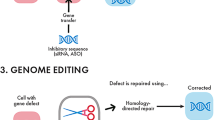Summary
Lesch-Nyhan syndrome is an X-linked disease caused by the deficiency of hypoxanthine phosphoribosyltransferase, an enzyme involved in the purine salvage pathways. It is characterized by severe gout, choreoathetosis, self-mutilatory behaviour and mental retardation. The derivation of mice genetically deficient in this enzyme may help to elucidate the pathogenesis of the neurological abnormality where previously models using drug administration to mimic the disorder have had to suffice.
Similar content being viewed by others
References
Allsop J, Watts RWE (1990) Purine synthesis de novo and salvage in hypoxanthine phosphoribosyltransferase-deficient mice.Enzyme 43: 155–159.
Ansell JD, Samuel K, Whittingham DG, et al (1991) Hypoxanthine phosphoribosyl transferase deficiency, haematopoiesis and fertility in the mouse.Development 112: 489–498.
Breese GR, Criswell HE, Duncan GE, Mueller RA (1990) A dopamine deficiency model of Lesch-Nyhan disease — the neonatal-6-OHDA-lesioned rat.Brain Res Bull 25: 477–484.
Capecchi MR (1989) Altering the genome by homologous recombination.Science 244: 1288–1292.
Dunnett SB, Sirinathsinghji DJS, Heavens R, Rogers DC, Kuehn MR (1989) Monoamine deficiency in a transgenic (Hprt−) mouse model of Lesch-Nyhan syndrome.Brain Res 501: 401–406.
Finger S, Heavens RP, Sirinathsinghji DJS, Kuehn MR, Dunnett SB (1988) Behavioral and neurochemical evaluation of a transgenic mouse model of Lesch-Nyhan syndrome.J Neurol Sci 86: 203–215.
Held I, Wells W (1969) Observations on purine metabolism in rat brain.J Neurochem 16: 529–536.
Hooper M, Hardy K, Handyside A, Hunter S, Monk M. HPRT-deficient (Lesch-Nyhan) mouse embryos derived from germline colonization by cultured cells.Nature 326: 292–295.
Jankovic J, Caskey TC, Stout JT, Butler IJ (1988) Lesch-Nyhan syndrome: A study of motor behavior and cerebrospinal fluid neurotransmitters.Ann Neurol 23: 466–469.
Jinnah HA, Gage FH, Friedmann T (1990) Animal models of Lesch-Nyhan syndrome.Brain Res Bull 25: 467–475.
Jinnah HA, Gage FH, Friedmann T (1991) Amphetamine-induced behavioral phenotype in HPRT-deficient mice.Behav Neurosci 105: 1004–1012.
Kuehn MR, Bradley A, Robertson EJ, Evans MJ (1987) A potential animal model for Lesch-Nyhan syndrome through introduction of HPRT mutations into mice.Nature 326: 295–298.
Lloyd KG, Hornykiewicz O, Davidson L, et al (1989) Biochemical evidence of dysfunction of brain neurotransmitters in the Lesch-Nyhan syndrome.N Engl J Med 305: 1106–1111.
Luthman J, Bolioli B, Tsutsumi T, Verhofstad A, Jonsson G (1987) Sprouting of striatal serotonin nerve terminals following selective lesions of nigro-striatal dopamine neurons in neonatal rat.Brain Res Bull 19: 269–274.
McDonald JA, Kelley WN (1972) Lesch-Nyhan syndrome: absence of mutant enzyme in erythrocytes of a heterozygote for both normal and mutant hypoxanthine guanine phosphoribosyltransferase.Biochem Genet 6: 21–26.
Moyer JD, Henderson JF (1983) Salvage of circulating hypoxanthine by tissues of the mouse.Can J Biochem Cell Biol 61: 1153–1157.
Munir MI, Rossiter BJF, Caskey CT (1990) Antisense RNA production in transgenic mice.Somat Cell Mol Genet 16: 383–394.
Palmiter RD, Brinster RL (1986) Germline transformation of mice.Annu Rev Genet 20: 465–499.
Payne MR, Dancis J, Berman PH, Balis ME (1970) Inosine kinase in leucocytes of Lesch-Nyhan patients.Exp Cell Res 59: 489–490.
Pierre KJ, LePage GA (1968) Formation of inosine-5′-monophosphate by a kinase in cell-free extracts of Ehrlich ascites cellsin vitro.Proc Soc Exp Biol Med 127: 432–440.
Silverstein FS, Johnston MV, Hutchinson MD, Edwards NL (1985) Lesch-Nyhan syndrome: CSF neurotransmitter abnormalities.Neurology 35: 907–911.
Stachowiak MK, Bruno JP, Snyder AM, Stricker EM, Zigmond MJ (1984) Apparent sprouting of striatal serotonergic terminals after dopamine-depleting brain lesions in neonatal rats.Brain Res 291: 164–167.
Stout JT, Caskey CT (1989) Hypoxanthine phosphoribosyltransferase deficiency: The Lesch-Nyhan syndrome and gouty arthritis. In Scriver CR, Beaudet AL, Sly WS, Valle D, eds.The Metabolic Basis of Inherited Disease. New York: McGraw-Hill, 1007–1028.
Stout JT, Chen HY, Brennand J, Caskey CT, Brinster RL (1985) Expression of human HPRT in the central nervous system in transgenic mice.Nature 317: 250–252.
Thompson S, Clarke AR, Pow AM, Hooper ML, Melton DW (1989) Germ line transmission and expression of a corrected HPRT gene produced by gene targeting in embryonic stem cells.Cell 56: 313–321.
Williamson DJ, Sharkey J, Clarke AR, et al (1991) Analysis of forebrain dopaminergic pathways in HPRT− mice. In Elion GB, Harkness RA, Zollner N, eds.Purine and Pyrimidine Metabolism in Man VII, Part B. New York: Plenum Press, 269–272.
Author information
Authors and Affiliations
Rights and permissions
About this article
Cite this article
Williamson, D.J., Hooper, M.L. & Melton, D.W. Mouse models of hypoxanthine phosphoribosyltransferase deficiency. J Inherit Metab Dis 15, 665–673 (1992). https://doi.org/10.1007/BF01799622
Issue Date:
DOI: https://doi.org/10.1007/BF01799622




